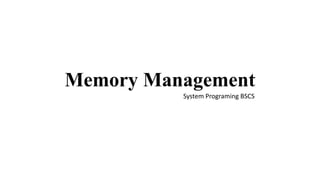
Memory Management.pptx
- 2. Introduction • Since C is a structured language, it has some fixed rules for programming. One of them includes changing the size of an array. An array is a collection of items stored at contiguous memory locations.
- 3. Dynamic Memory Allocation in C • If there is a situation where only 5 elements are needed to be entered in this array. In this case, the remaining 4 indices are just wasting memory in this array. So there is a requirement to lessen the length (size) of the array from 9 to 5. • Take another situation. In this, there is an array of 9 elements with all 9 indices filled. But there is a need to enter 3 more elements in this array. In this case, 3 indices more are required. So the length (size) of the array needs to be changed from 9 to 12.
- 4. Dynamic Memory Allocation in C • Dynamic Memory Allocation is a way through which the size of data structure can be changed during execution (on run time). • Memory assigned to a program in a typical architecture can be divided into four segments. • Code • Static/ Global Variables. • Stack • heap
- 5. The Process’s Memory • Each process has its own virtual address space dynamically translated into physical memory address space by the MMU (and the kernel.) • This space is divided in several part, • A stack where local and volatile data are stored, • Global variables and an unorganized space for program’s data called the heap. • The heap is a continuous (in term of virtual addresses) space of memory with three bounds: • a starting point • a maximum limit (managed through sys/ressource.h’s functions getrlimit(2) and setrlimit(2)) • End point called the break. • The break marks the end of the mapped memory space, that is, the part of the virtual address space that has correspondence into real memory.
- 6. Family of stdlib.h • Dynamic memory allocation could be achieved by using four functions: • malloc() • calloc() • free() • realloc()
- 7. malloc • Malloc( ) stands for memory allocation • It reserves a block of memory with the given amount of bytes. • The return value is a void pointer to the allocated space • Therefore the void pointer needs to be casted to appropriate type as per the requirement. • However, if the space is insufficient, allocation of memory fails and returns a NULL pointer. • All the values at allocated memory are initialized to garbage values
- 8. Syntax of malloc ptr = (cast-type*) malloc(byte-size) For Example: ptr = (int*) malloc(100 * sizeof(int)); • Since the size of int is 4 bytes, this statement will allocate 400 bytes of memory. And, the pointer ptr holds the address of the first byte in the allocated memory. • If space is insufficient, allocation fails and returns a NULL pointer.
- 9. #include <stdio.h> #include <stdlib.h> int main() { int* ptr; int n, i; printf("Enter number of elements:"); scanf("%d",&n); printf("Entered number of elements: %dn", n); ptr = (int*)malloc(n * sizeof(int)); if (ptr == NULL) { printf("Memory not allocated.n"); exit(0); } else { printf("Memory successfully allocated using malloc.n"); for (i = 0; i < n; ++i) { ptr[i] = i + 1; } printf("The elements of the array are: "); for (i = 0; i < n; ++i) { printf("%d, ", ptr[i]); } } return 0; }
- 10. brk(2) and sbrk(2) • brk(2) place the break at the given address addr and return 0 if successful, -1 otherwise. The global errno symbol indicate the nature of the error. int brk(const void *addr ); • sbrk(2) move the break by the given increment (in bytes.) Depending on system implementation, it returns the previous or the new break address. On failure, it returns (void *)-1 and set errno. void* sbrk(intptr_t incr ); • On some system sbrk accepts negative values (in order to free some mapped memory.)
- 11. The Process’s Memory.. In order to code a malloc, we need to know where the heap begin and the break position, and of course we need to be able to move the break. This the purpose of the two syscalls brk and sbrk.
- 12. Calloc() • Calloc() stands for Contiguous allocation • It reserves n blocks of memory with the given amount of bytes • The return value is a void pointer to the allocated space • Therefore the void pointer needs to be casted to the appropriate type as per the requirments • However, if the space is sufficient, allocation of memory fails and it return a null pointer. • All the values at allocated memory are initialized to 0 • Systanx: • Prt = (ptr-type*) calloc (n, size_in_bytes)
- 13. Realloc() • realloc() stands for reallocation • If the dynamically allocated memory is insufficient we can change the size of the pervious allocated memory using realloc () function • Syntax: • Ptr = (ptr-type*) realloc (ptr, new_size_in_bytes)
- 14. Free() • Free() is used to free the allocated memory • If the dynamically allocated memory is not required anymore, we can free it using free function • This will free the memory being used by the program in the heap • Syntax: • free(ptr)
- 15. Difference between malloc() and calloc() S.No. malloc() calloc() 1. malloc() function creates a single block of memory of a specific size. calloc() function assigns multiple blocks of memory to a single variable. 2. The number of arguments in malloc() is 1. The number of arguments in calloc() is 2. 3. malloc() is faster. calloc() is slower. 4. malloc() has high time efficiency. calloc() has low time efficiency. 5. The memory block allocated by malloc() has a garbage value. The memory block allocated by calloc() is initialized by zero. 6. malloc() indicates memory allocation. calloc() indicates contiguous allocation.